Which Leadership style is the best?
Usually, we are quick to answer: “Coaching Leadership Style.” But is this always the right answer? What about a crisis situation or a team with completely inexperienced members? Would the coaching style still be the best choice?
Moreover, we can use different leadership styles simultaneously, taking the best out of each and adding more tools to our belt. The choice depends on the situation, the maturity of the team, the organization we work in, the individuals in our team, as well as our own unique personality.
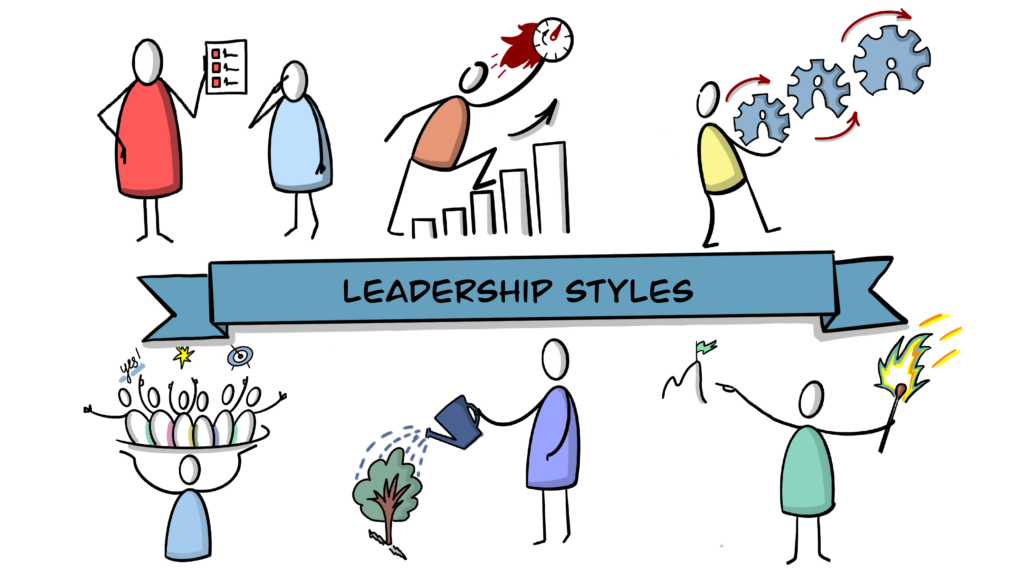
Leadership styles are not something rigid to follow letter for letter. While people might embrace a particular style in general, there can still be differences, and not all characteristics are adhered to completely.
Leadership styles are tentative, and there are many other models of leadership styles (the models that inspired me). However, I find it useful to use the six styles outlined below during leadership training programs, as these are the ones I have most often observed in the organizations I work in and with.
1. Commanding Leadership Style
2. Pacesetting Leadership Style
3. Coordinating Leadership Style
* The limitation of the first three styles
4. Enabling Leadership Style
5. Coaching Leadership Style
6. Catalyzing Leadership Style
* Conclusion
* Models that inspired me
1. Commanding Leadership Style
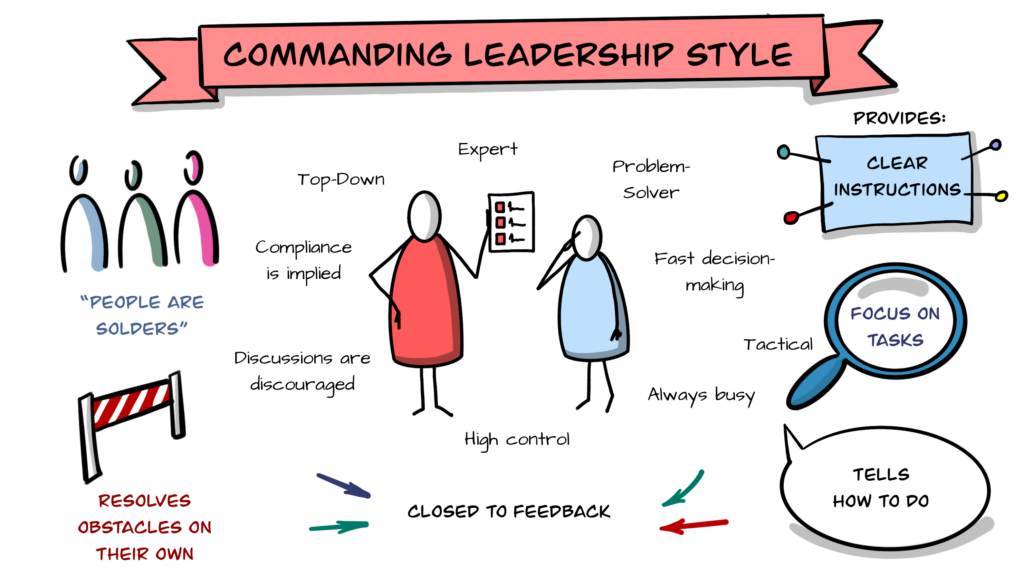
This style is often embraced by first-time managers. Typically, they have been promoted to managerial positions because of their high expertise in their field. With more experience than their team members, they often take on tasks themselves or provide very specific instructions on how things should be done, expecting others to follow exactly.
This type of manager is often referred to as a micromanager. They need to control everything, or at least as much as possible—otherwise, they assume something bad will happen and things will go out of control. This is usually because they don’t have much faith in their team members’ capabilities.
In their perspective, people are meant to execute their directions—much like soldiers. Or often such leaders see people as problems – because they never measure up to the leader’s standards and cannot perform tasks “properly.” As a result, this type of manager often feels desperate, constantly busy, and exhausted.
Managers who use this style might have a negative reputation, but more often than not, they are genuinely trying their best to be great leaders—they just don’t know how to do it better. They feel deeply responsible for everything, which drives their urge to control every aspect of the work.
However, in modern knowledge-work environments, such a style rarely produces good results, as teams need members who show initiative, express their opinions freely, use their collective intelligence, and collaborate to find effective solutions. This type of manager will hinder all of this and serve as a Single Point of Failure.
Nevertheless, there are situations where this style might work—for example, during a crisis where quick decisions and strict adherence to instructions are crucial, or in highly structured environments like the military. It can also be effective when working with completely inexperienced team members who need clear guidance to get started.
2. Pacesetting Leadership Style
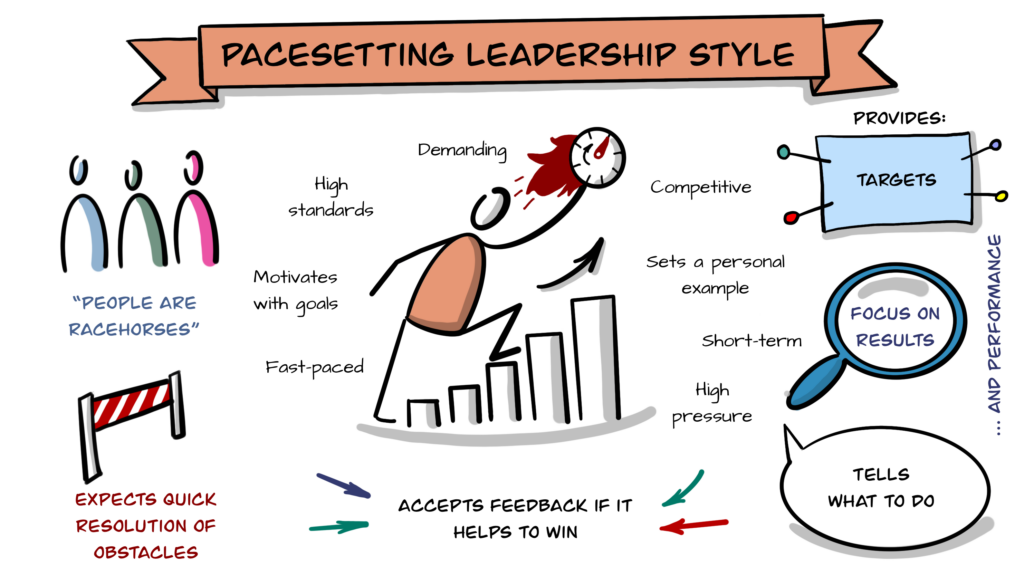
The Pacesetting Leadership Style is defined by high standards, a fast pace, and a relentless focus on results. Leaders using this style set ambitious goals and lead by example, demonstrating the performance they expect from their teams. They are demanding and competitive, driving their teams to deliver exceptional results in a short amount of time. For them, people are like racehorses—valued for their ability to perform at a high level and achieve targets quickly.
This style might be effective in specific situations, such as with sales teams, start-ups in their early stages, or during crisis situations where quick results are critical. It can also work well in short-term competitions, where speed and performance are the primary focus, when meeting tight deadlines on high-stakes projects, or in crisis recovery scenarios where swift action is essential to stabilize the situation.
However, the main risk of this style is its short-term focus. It can lead to burnout and reduced morale if overused, as the constant pressure and demand for performance are not sustainable in the long run. As such, it should be applied temporarily and with careful consideration of the team’s capacity and team members’ personalities—it might work better with people who are highly competitive themselves, but it can be completely disastrous for those who thrive in calm and collaborative environments.
Simply put, this style might work well for sales teams but can be but can be
absolutely unsuitable for software engineering teams. In the long run, it can be harmful to any team, often leading to burnout.
3. Coordinating Leadership Style
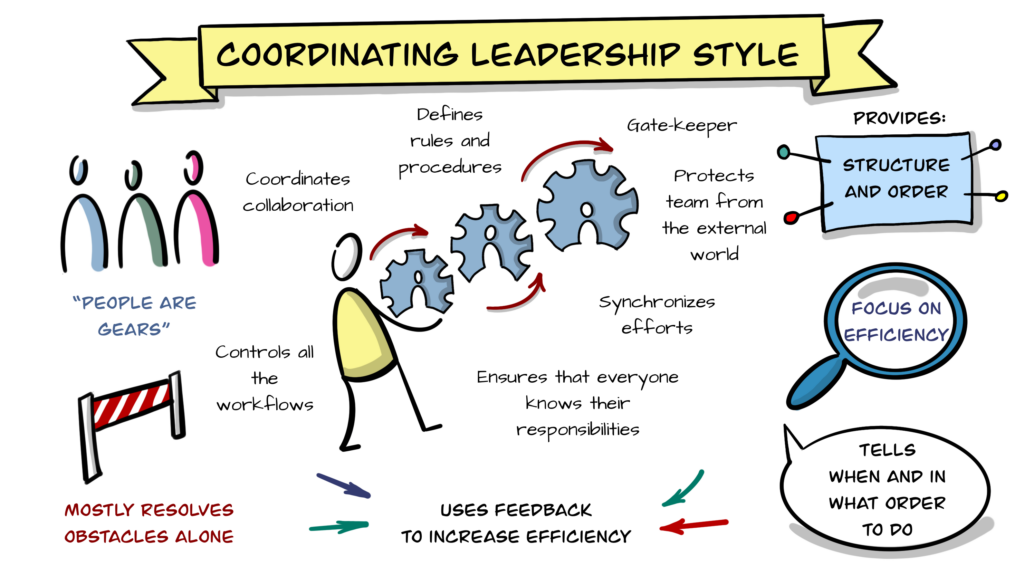
This style leans more towards being a project manager than a genuine leader. The Coordinating Leader ensures that every piece fits perfectly, controlling workflows, defining rules and procedures, and synchronizing efforts to maintain structure and order. People are often perceived as gears within a larger machine, working in sync to keep everything moving efficiently (or sometimes simply as “resources,” a notion common to all three preceding leadership styles).
While this approach can be effective in environments requiring strict organization or managing predictable, complicated processes, it is less suited for complex environments where innovation, creativity, adaptability, and decentralized decision-making are important.
This style may also work well for newer teams, but as the team matures, the need for control should gradually give way to greater autonomy and shared ownership.
The limitation of the first three styles
The common limitation of the first three leadership styles is that leaders often feel over-responsible and try to control everything. This makes them the Single Point of Failure, seemingly irreplaceable, but also undermines team members’ sense of responsibility.
This creates a vicious cycle:
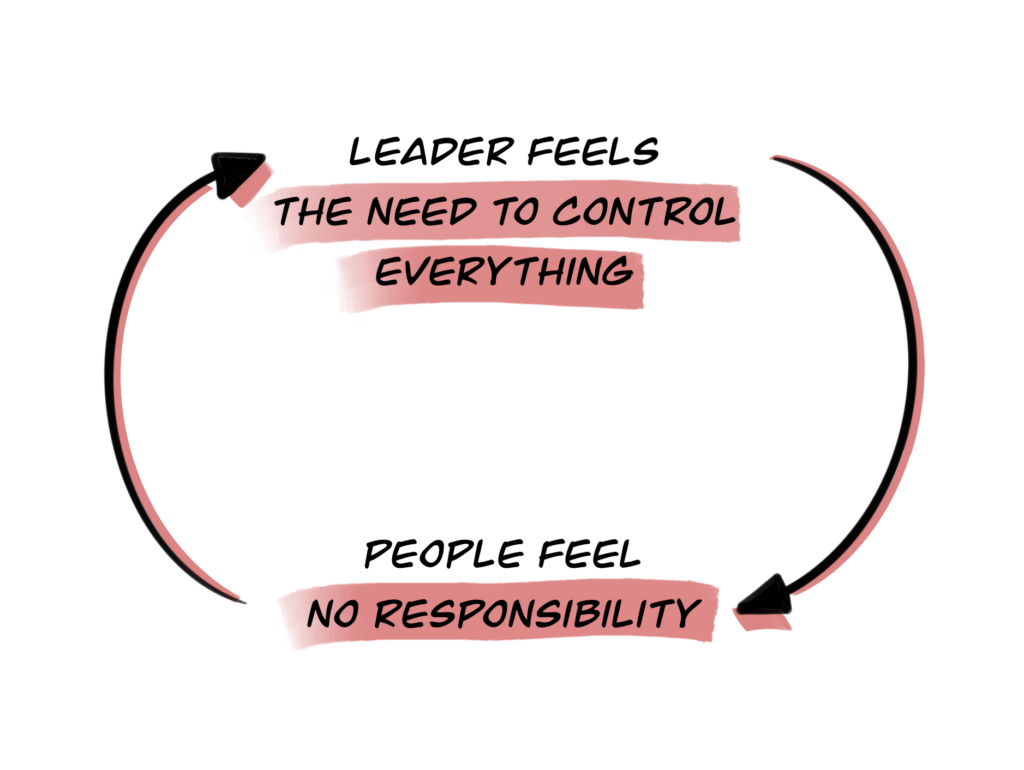
This creates a vicious cycle:
- When leaders feel they are the only ones capable of making decisions, their team members never learn to make decisions themselves—or lose that ability altogether. As a result, the leaders feel even more strongly that they must make all the decisions.
- When leaders control everything, their people don’t develop autonomy or lose whatever autonomy they previously had. This leads the leaders to feel an even greater need to control.
- When leaders take on too much responsibility, their team members take little ownership. In response, the leaders shoulder even more responsibility.
This is the law of unintended consequences in action.
The outcome? A leader who becomes busier and busier—or perhaps just feels more and more important. 😉
4. Enabling Leadership Style
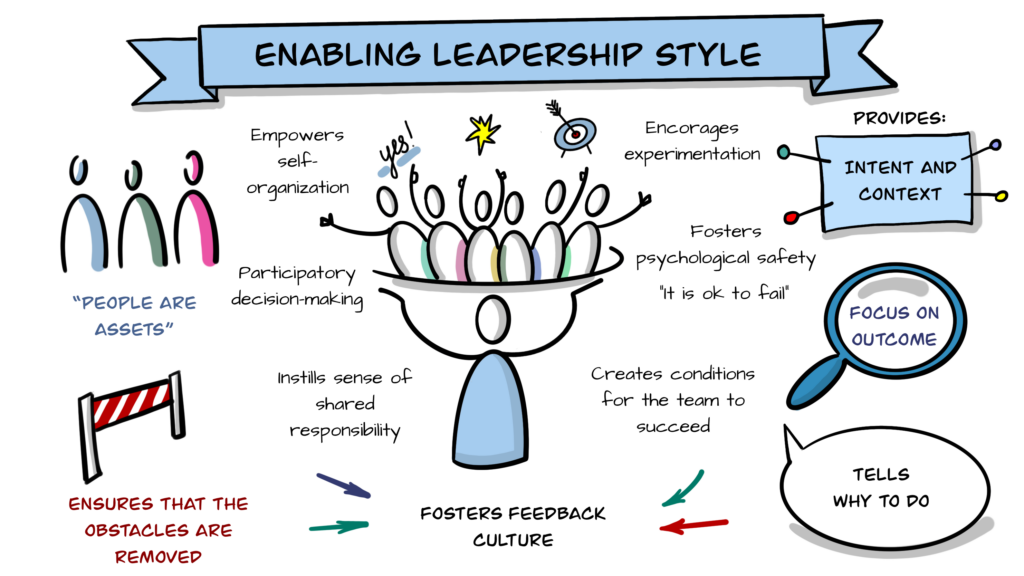
The Enabling Leadership Style focuses on shifting responsibility and control from the leader to the team, fostering strong teamwork rather than relying primarily on 1-on-1 relationships and communication.
This leadership style centers on creating the right conditions for teams to thrive in complex environments. Leaders who adopt the Enabling Style focus on empowering self-organization, fostering shared responsibility, and providing the intent and context needed for success. They see people as true assets with the potential to innovate, grow, and contribute meaningfully.
These leaders prioritize participatory decision-making, encourage experimentation, and emphasize psychological safety by reinforcing the idea that “It is okay to fail.” They ensure that obstacles to progress are removed—either directly or, more often, by empowering teams to do so themselves. By creating the right environment, they enable their teams to focus on achieving outcomes.
The Enabling Leadership Style is particularly effective in complex environments that demand creativity, adaptability, and resilience. It fosters a sense of belonging and cultivates a blame-free feedback culture. It is this style that helps Agile teams unlock their potential and thrive.
However, this style can be risky when teams lack the readiness or skills for self-organization, leading to confusion. It might not be the best choice in crisis situations requiring quick, decisive action, and can become inefficient when participatory decision-making delays progress under pressure or tight deadlines.
5. Coaching Leadership Style
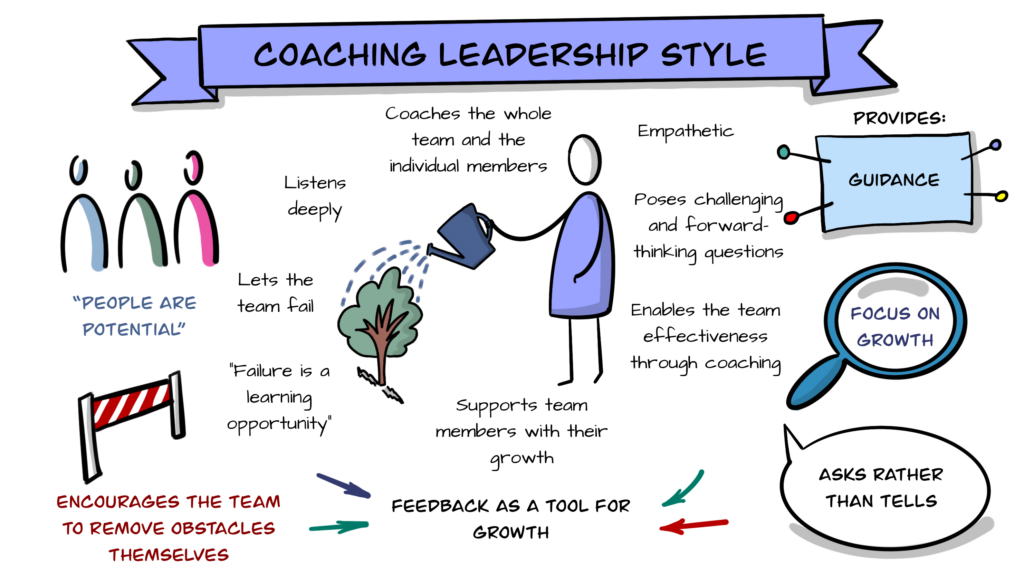
This style emphasizes growth, empowerment, and learning. Leaders adopting the Coaching Style see people as potential waiting to be developed. They focus on guiding both the team as a whole and individual members by listening deeply, asking thought-provoking questions, encouraging forward-thinking, and enabling team effectiveness through coaching.
These leaders encourage the team to take ownership, solve their own obstacles, and view failure as an opportunity for learning. By fostering a culture of growth and empathy, they support team members in reaching their full potential while strengthening the team’s overall capability.
The Coaching Leadership Style is particularly effective in environments where long-term development, adaptability, and trust are valued. However, it requires patience, as the results may take time to manifest.
The Coaching Leadership Style might not work well in situations requiring immediate results or quick decision-making, as its focus on growth and long-term development may delay progress. Additionally, in high-pressure or crisis scenarios, the time required for coaching and fostering forward-thinking may not align with the urgency of the situation. Sometimes, people simply need direct instructions—especially when they lack experience or knowledge.
6. Catalyzing Leadership Style
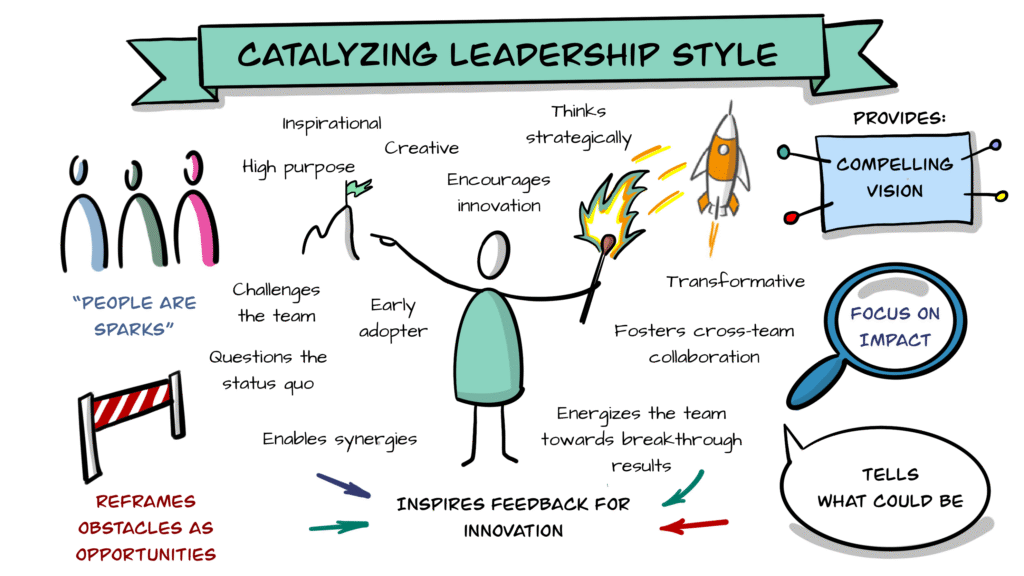
The Catalyzing Leadership Style (or Visionary Leadership Style) inspires teams with a compelling vision and drives them toward transformative, high-impact results. Leaders adopting this style see people as sparks capable of igniting innovation and breakthroughs. They challenge teams to push boundaries, energize efforts, and foster cross-team collaboration, reframing obstacles as opportunities for growth and creativity.
This style thrives in environments requiring bold ideas, significant change, or a unifying purpose. It excels in scenarios where organizations seek to rally teams around a shared vision, such as driving innovation, launching transformative initiatives, or pursuing ambitious, long-term goals. Catalyzing leadership can inspire creativity, foster collaboration across teams, and generate momentum for achieving breakthrough results. For example, it works well in start-ups aiming to disrupt markets or organizations undergoing cultural or strategic reinvention.
However, it may be less effective in highly regulated industries where strict compliance is essential, or in routine, repetitive work settings where innovation may seem unnecessary. Teams that lack trust or cohesion might also struggle to unite behind a shared vision. Additionally, inexperienced teams needing detailed guidance or short-term crisis situations requiring immediate decisions may not align well with this style’s focus on long-term impact and inspiration.
Conclusion
So – what is the best leadership style? As we see, there is no one-size-fits-all answer. Different styles serve different purposes, and their effectiveness depends on the context, the team’s needs, and the challenges at hand. From fostering innovation to managing crises or ensuring efficiency, each style has its strengths and limitations.
Rather than adhering to a single style, we have the freedom to choose our leadership style or combine behaviors from various styles to create our very own unique approach—one that aligns with our personality, fits the needs of our team and organization, and helps us navigate the challenges we face.
Leadership styles are neither absolute truths nor fixed formulas but rather useful models, simplifications of reality, that help us assess, understand, and reflect on our behaviors. They can serve as reference points for navigating different situations, but the reality is always more nuanced than any model can capture.
Inspirations
There are several models, those that were the most inspirational for me are:
1. The Six Goleman Leadership Styles:
2. The Five Levels of Leadership Agility by Bill Joiner & Stephen Josephs:
3. The Six Leadership Styles by agile42
- Directing
- Demanding
- Conducting.
- Envisioning.
- Coaching
- Catalyzing.
and there are quite a few (actually many) more models of Leadership Styles.
And as we know: “All models are wrong, but some are useful.” (the quote attributed to statistician George E.P. Box)




